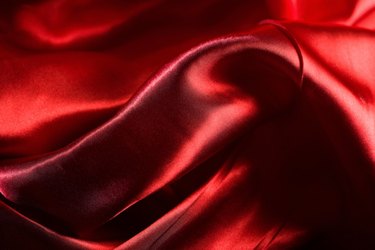Things You'll Need
Tweezers
Microscope

Lush fabric with a soft hand and lustrous sheen are recognizable similarities when working with silk as well as rayon textiles. Though these delicate fabrics are often challenging to differentiate, the main difference is in the yarn quality, which is recognizable when untwisted. Silk is a natural fiber that comes in a filament form. Long fibered silk yarn is reeled and short fibers are spun. Rayon is a manufactured fiber composed of regenerated cellulose, which undergoes two different processes: cuprammonium and viscose. By untwisting the silk and rayon yarns, the differences become visible.
Determining Silk Textile
Step 1
Check the denier count of the silk material. Yarns are assigned size numbers to distinguish textile differences in weight and fineness. Count applies to cotton, wool and spun yarns, lea applies to linen and denier applies to reeled silk as well as filament man-made yarns. The lower the denier number, the finer the yarn.
Video of the Day
Step 2
Check the fabric content. If you are purchasing silk by the yard at your local fabric store, ask the shop representative for the content tag. It is usually located inside of the fabric roll. For example, 100 percent silk states if the textile is spun silk.
Step 3
Unravel a small section along the raw edge of the fabric by pulling apart the frayed yarns. Use tweezers to set the yarns apart. Do not attempt to unravel along the selvages, which are the side edges of the fabric generally distinguishable by the warp in the textile.
Step 4
Untwist one yarn gently. Reeled silk has less twist than spun. It is naturally more lustrous than spun silk. As you continue to untwist the yarns in your fingers, the reeled silk yarn will start to fan out or shred apart.
Step 5
Untwist the spun silk yarns as in step 4. Spun silk yarns are generally dull and cotton-like. These highly twisted yarns require extra time to untwist. Since the fibers are shorter, the high twist holds the short ends together. As you continue to untwist the yarn with your fingers, the fibers do not lie parallel and appear of varied short lengths.
Video of the Day
Determining Rayon Textile
Step 1
Check the fabric content for the rayon fabric as in section 1, step 2.
Step 2
Unravel and untwist a yarn along the raw edge of the fabric as in section 1, steps 3 and 4. Untwisting the yarns allow you to determine through microscopic examination the process used to produce the rayon during the manufacturing process. Cuprammonium rayon is filaments made of regenerated cellulose coagulated from a solution of cellulose in ammoniacal oxide while viscose rayon is coagulated from a solution of cellulose xanthate.
Step 3
Place the rayon yarn under a microscope. This step determines if the rayon is viscose or cuprammonium. Viscose fibers appear even and rod-like. Small, lengthwise shadows, referred to as striations, are distinguishing features of the lustrous viscose textile. Dull viscose rayon material has visible specked fibers with a pepper-like appearance. Cuprammonium fibers are even in diameter and appear rod-like as well when viewed under the microscope. However, no visible lengthwise markings are visible as in the viscose fiber.